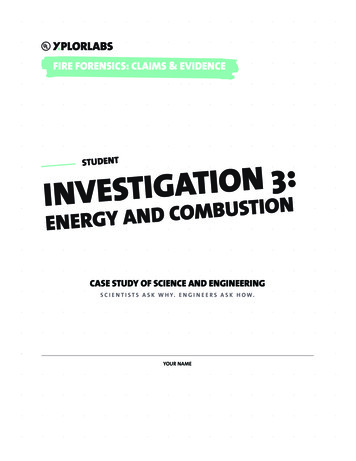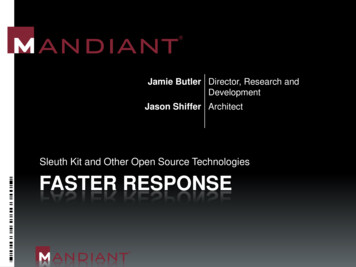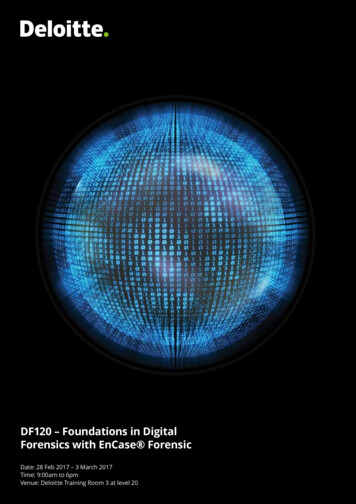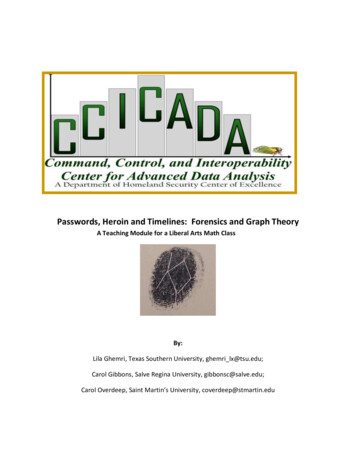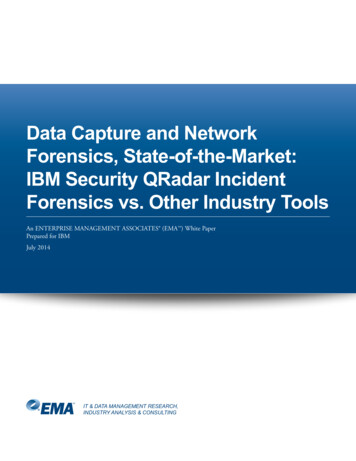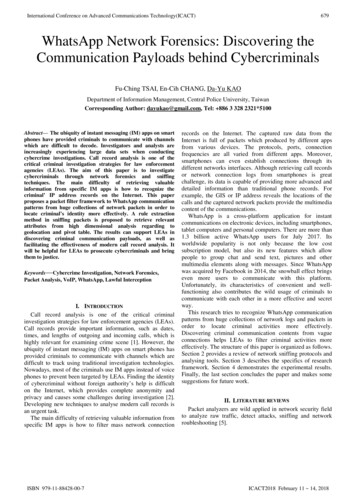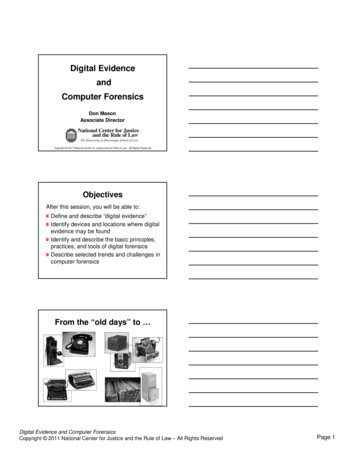
Transcription
Digital EvidenceandComputer ForensicsDon MasonAssociate DirectorCopyright 2011 National Center for Justice and the Rule of Law – All Rights ReservedObjectivesAfter this session, you will be able to:Define and describe “digital evidence”Identify devices and locations where digitalevidence may be foundIdentify and describe the basic principles,practices, and tools of digital forensicsDescribe selected trends and challenges incomputer forensicsFrom the “old days” to Digital Evidence and Computer ForensicsCopyright 2011 National Center for Justice and the Rule of Law – All Rights ReservedPage 1
Evolving technology in The “Digital age” with Convergent, “Smart” DevicesDigital Evidence and Computer ForensicsCopyright 2011 National Center for Justice and the Rule of Law – All Rights ReservedPage 2
Cellular phone a “computer”?Yes, as defined in Computer Fraud andAbuse Act– U.S. v. Kramer, 631 F.3d 900 (Feb 8, 2011)Ultimately, does it make any differencewhether a device capable of storing digitalevidence is deemed to be a “computer”?Computers Digital DevicesA computer is like a light switchSwitchONOFFComputersignal presentBinary Symbol1no signal present0Each 0 or 1 is a BIT (for BINARY DIGIT)00000001 10 0 0 0 0 0 1 0 2 (2 0)0 0 0 0 0 0 1 1 3 (2 1)An 8-bit sequence 1 byte a keystrokeDigital DevicesPrinter MonitorComputerDigital Evidence and Computer ForensicsCopyright 2011 National Center for Justice and the Rule of Law – All Rights ReservedPage 3
The Investigative Future is HereCriminal es!From homes, offices,coffee shops, airplanes,cars, buses, trains, almost anywhereAlways Something NewAnd Yet NewerDigital Evidence and Computer ForensicsCopyright 2011 National Center for Justice and the Rule of Law – All Rights ReservedPage 4
Roles of Digital Devices Computer as Target Unauthorized access, damage, theft Spam, viruses, worms Denial of service attacks Computer as Tool Fraud Threats, harassment Child pornography Computer as Container From drug dealer records to how to commitmurderDigital EvidenceInformation of probative value that isstored or transmitted in binary form andmay be relied upon in courtTwo typesDigital EvidenceUser-created– Text (documents, e-mail, chats, IM’s)– Address books– Bookmarks– Databases– Images (photos, drawings, diagrams)– Video and sound files– Web pages– Service provider account subscriber recordsDigital Evidence and Computer ForensicsCopyright 2011 National Center for Justice and the Rule of Law – All Rights ReservedPage 5
Digital EvidenceComputer/Network-created– Email headers– Metadata– Activity logs– Browser cache, history, cookies– Backup and registry files– Configuration files– Printer spool files– Swap files and other “transient” data– Surveillance tapes, recordingsForms of EvidenceFiles– Present / Active (doc’s, spreadsheets, images,email, etc.)– Archive (including as backups)– Deleted (in slack and unallocated space)– Temporary (cache, print records, Internet usagerecords, etc.)– Encrypted or otherwise hidden– Compressed or corruptedFragments of Files– Paragraphs– Sentences– WordsHow Much Data?1 Byte (8 bits): A single character1 Kilobyte (1,000 bytes): A paragraph1 Megabyte (1,000 KB): A small book1 Gigabyte (1,000 MB): 10 yards of shelved books1 Terabyte (1,000 GB): 1,000 copies of Encyclopedia1 Petabyte (1,000 TB): 20 million four-door filing cabinetsof text1 Exabyte (1,000 PB): 5 EB All words ever spoken byhumans1 Zettabyte (1,000 EB, or 1 billion TB) 250 billion DVDs,36 million years of HD video, or the volume of the GreatWall of ChinaDigital Evidence and Computer ForensicsCopyright 2011 National Center for Justice and the Rule of Law – All Rights ReservedPage 6
Data Generated in 20101200 trillion gigabytes (1.2 zettabytes)89 stacks of books each reachingfrom the Earth to the Sun22 million times all the books everwrittenWould need more than 750 millioniPods to hold it107 trillion emails sent in 2010ProjectionIn 2020: 35 zettabytes will beproduced– All words ever spoken by human beings,written 7 timesHow Much in Real Cases?One recent example:– 17 terabytes– 24 million images– 17,000 movies– 4600 CVIP hits (known CP images)Digital Evidence and Computer ForensicsCopyright 2011 National Center for Justice and the Rule of Law – All Rights ReservedPage 7
Sources of EvidenceOffender’s computer– accessed and downloaded images– documents– chat sessions– user log files– Internet connection logs– browser history and cache files– email and chat logs– passwords & encryption keysSources of EvidenceServers– ISP authentication user logs– FTP and Web server access logs– Email server user logs– LAN server logs– “Cloud” storage– Web pages– Social mediaSources of EvidenceOnline activity– Internet Protocol addresses– Router logs– Third party service providersDigital Evidence and Computer ForensicsCopyright 2011 National Center for Justice and the Rule of Law – All Rights ReservedPage 8
"inside the box, outside thebox"The BoxOutside the box:network investigationsInside the BoxWhat the computer owner actually has possession ofComputer’s hard driveand other memory––––DocumentsPicturesOutlook EmailsInternet CacheCD’s and floppy disksiPodsCell PhonesExternal Hard DrivesInside the BoxWhat the computer owner actually has possession ofDigital Evidence and Computer ForensicsCopyright 2011 National Center for Justice and the Rule of Law – All Rights ReservedPage 9
Outside the BoxWhat is not stored on the owner’s computerOnline Email Accounts (Gmail and Yahoo)Internet Shopping AccountsSocial Networking AccountsBackups of text messagesCell Site Location DataUsing Pen/Trap for Internet “DRAS” informationSubscriber account recordsContents of WebsitesOutside the BoxWhat is not stored on the owner’s computerComputer ForensicsDigital Evidence and Computer ForensicsCopyright 2011 National Center for Justice and the Rule of Law – All Rights ReservedPage 10
Computer ForensicsObtaining,Processing,Authenticating, andProducingdigital data/records for legal proceedings.Computer ForensicsUsually pre-defined procedures followedbut flexibility is necessary as the unusualwill be encounteredWas largely “post-mortem”– “What’s on the hard drive?”Rapidly evolving– Ex:From “Pull the plug”to“Don’t power down before you know what’s on it”Terms, Branches, TrendsComputer forensicsNetwork forensics“Live” forensicsSoftware forensicsImage forensicsMobile device forensics“Browser” forensics“Triage” forensics“Distributed” forensicsDigital Evidence and Computer ForensicsCopyright 2011 National Center for Justice and the Rule of Law – All Rights ReservedPage 11
Digital Knowledgeand Intent EvidenceEvidence that the CP files were purposely collected––––CP found in computer’s allocated space?In folders assigned to particular “user” of the computer?Files organized, given relevant folder/file titles?Default settings of the computer’s software changed?Evidence that CP was obtained via Web browsing– Evidence in the Index.dat files of web searches for CP?– CP found in the Temporary Internet Files?– Any CP-related Bookmarks/Favorites saved?Evidence that the CP was viewed by a user– Any Recent Files/Link Files to the CP?– Windows Registry list other devices (scanners, thumb drives, etc.)recently connected to the computer?– Any Thumbs.db files containing CP?– Any CP videos listed in Windows Media Player/Real Playerhistories?34Basic StepsAcquiring (and preserving)evidence without altering ordamaging original dataAuthenticating acquired evidenceby showing it’s identical to dataoriginally seizedAnalyzing (searching for) theevidence without modifying itPopular Automated ToolsEncaseGuidance rensic Tool Kit (FTK)Access DataDigital Evidence and Computer ForensicsCopyright 2011 National Center for Justice and the Rule of Law – All Rights ReservedPage 12
Skills / Expertise RequiredTechnical– Data processing and productionInvestigative– Understanding computer evidence– Building a caseLegal– Maintaining chain of custody– Managing digital evidence per the rulesCertificationsVarious offered– IACIS’s “CFCE”– Guidance Software’s “Encase CE”– ISFCE’s “CCE”Some states require P.I. licensesGrowing number of schools offeringcertificate and degree programsBut no uniform, accepted standardsAcquiring the EvidenceSeizing computer (“bag and tag”)Handling computer evidence carefully– Chain of custody– Evidence collection (including volatile memory)– Evidence identification– Transportation– StorageMaking at least two images of each container– Perhaps 3rd in criminal caseDocumenting, Documenting, DocumentingDigital Evidence and Computer ForensicsCopyright 2011 National Center for Justice and the Rule of Law – All Rights ReservedPage 13
Preserving Digital EvidenceThe “Forensic Image” or “Duplicate”A virtual “clone” of the entire drive Every bit & byte “Erased” & reformatted data Data in “slack” & unallocated space Virtual memory dataAuthenticating the EvidenceProving that evidence to be analyzed isexactly the same as what suspect/partyleft behind– Readable text and pictures don’t magicallyappear at random– Calculating hash values for the originalevidence and the images/duplicatesMD5 (Message-Digest algorithm 5)SHA (Secure Hash Algorithm)(NSA/NIST)What Is a Hash Value?An MD5 Hash is a 32 character string that lookslike:Acquisition Hash:3FDSJO90U43JIVJU904FRBEWHVerification Hash:3FDSJO90U43JIVJU904FRBEWHThe Chances of two different inputs producingthe same MD5 Hash is greater than:1 in 340 Unidecillion: or 1 in 0Digital Evidence and Computer ForensicsCopyright 2011 National Center for Justice and the Rule of Law – All Rights ReservedPage 14
Hashing Tools – /www.slavasoft.com/hashcalc/index.htmAlso, AccessData’s FTK Imager can bedownloaded free athttp://www.accessdata.com/downloads.htmlMD5 Hash128-bit (16-byte) message digest –a sequence of 32 characters“The quick brown fox jumps over the lazydog”9e107d9d372bb6826bd81d3542a419d6“The quick brown fox jumps over the www.miraclesalad.com/webtools/md5.phpDigital Evidence and Computer ForensicsCopyright 2011 National Center for Justice and the Rule of Law – All Rights ReservedPage 15
“Hashing” an cdfeb88b69cbcAnalyzing the EvidenceWorking on bit-stream images of theevidence; never the original– Prevents damaging original evidence– Two backups of the evidenceOne to work onOne to copy from if working copy alteredAnalyzing everything– Clues may be found in areas or filesseemingly unrelatedAnalysis (cont’d)Existing Files– Mislabeled– HiddenDeleted Files– Trash Bin– Show up in directory listing with in placeof first letter“taxes.xls” appears as “ axes.xls”Free SpaceSlack SpaceDigital Evidence and Computer ForensicsCopyright 2011 National Center for Justice and the Rule of Law – All Rights ReservedPage 16
Forms of EvidenceFiles– Present / Active (doc’s, spreadsheets, images,email, etc.)– Archived (including as backups)– Deleted (in slack and unallocated space)– Temporary (cache, print records, Internet usagerecords, etc.)– Encrypted or otherwise hidden– Compressed or corruptedFragments– Paragraphs– Sentences– WordsSources of Digital GoldInternet historyTemp files (cache, cookies etc )Slack/unallocated spaceBuddy lists, chat room records, personal profiles, etc.News groups, club listings, postingsSettings, file names, storage datesMetadata (email header information)Software/hardware addedFile sharing abilityEmailHow Data Is StoredTrackSectorClusters aregroups of sectorsDigital Evidence and Computer ForensicsCopyright 2011 National Center for Justice and the Rule of Law – All Rights ReservedPage 17
How Data Is StoredFiles are written to ClustersEach file may occupymore or less than fullclustersMay write to noncontiguous clustersHow Data Is StoredEvery file in a computer fills aminimum amount of space– In some old computers, one kilobyte(1,024 bytes). In newer computers,32 KB (32,768 bytes).– If file is 2,000 bytes long, everythingafter the 2000th byte is slack space.Free SpaceCurrently unoccupied, or“unallocated” spaceMay have held information beforeValuable source of data– Files that have been deleted– Files that have been moved duringdefragmentation– Old virtual memoryDigital Evidence and Computer ForensicsCopyright 2011 National Center for Justice and the Rule of Law – All Rights ReservedPage 18
Slack SpaceSpace not occupied by an activefile, but not available for use by theoperating systemHow “Slack” Is GeneratedFile BFile Bsaved(Draftin RAM) to disk,on topof File AFile BFile Bover(Nowwrites on disk)part ofFile AFile A, Remains(“Erased,” creating of File A(Slack)on disk)slackFile B(Savedto disk)Slack space: The area between the endof the file and the end of the storage unitSelected Developmentsin Digital Forensics“Browser” Forensics“Triage” ForensicsDigital Evidence and Computer ForensicsCopyright 2011 National Center for Justice and the Rule of Law – All Rights ReservedPage 19
“Browser” ForensicsWeb browsers (e.g. Microsoft InternetExplorer, Mozilla Firefox, Safari, Opera)maintain histories of recent activity,even if not web relatedInternet HistoryComputers store Internet history in anumber of locations including:––––Temporary Internet filesWindows RegistryBrowser / Search Term historyCookiesThis information is browser specific59“Triage” Forensics“Rolling” forensics, or on-site “preview”Image scanEspecially useful in “knock & talk”consent situations, screening multiplecomputers to determine which to seize, orprobation or parole monitoringNot all agencies equipped or trained yetto do this.Digital Evidence and Computer ForensicsCopyright 2011 National Center for Justice and the Rule of Law – All Rights ReservedPage 20
“Triage” ForensicsIncreasingly important, as the number andstorage capacities of devices rapidly grow.But does NOT enable a comprehensiveforensically sound examination of anydevice on the scene.“When is enough enough?”“Triage” Forensics - StepsAttach/Install write-blocking equipmentTurn on target deviceScan for file extensions, such as:.doc.jpg (.jpeg).mpg (.mpeg).avi.wmv.bmp“Triage” Forensics - StepsAttach/Install write-blocking equipmentTurn on target deviceScan for file extensions, such as:.doc.jpg (.jpeg).mpg (.mpeg).avi.wmv.bmpDigital Evidence and Computer ForensicsCopyright 2011 National Center for Justice and the Rule of Law – All Rights ReservedPage 21
“Triage” Forensics - StepsPull up thumbnail views - 10-96 images at a timeRight click on image, save to CD or separatedrive.Determine file structure or file path.Ways of Trying to Hide Data Password protectionschemes Encryption Steganography Anonymous remailers Proxy servers Changing File ExtensionsPassword ProtectionComputer/BIOS PasswordsEncryption ProgramsArchive PasswordsDocument PasswordsDigital Evidence and Computer ForensicsCopyright 2011 National Center for Justice and the Rule of Law – All Rights ReservedPage 22
Changing File ExtensionsEncryptionSometimes used as security measureto prevent others from accessing filedata.– Example: "Pretty Good Privacy“Scrambles file data so that it is unusable.EncodedDecodedbegin cindy.jpgM ]C X 02D9)1@ ! 0 0 ! # VP!# X*"PT "0X-# )3E9875Y . 5F;65:;%-;75GMVP!# 0\0 9M65E965E965E965E965E965E965E965G P 1" #P ,D# 2( A ! Q ! \0 M'P 04! 0 ! 0 " P0%!@ ("0H \0 M1 @ # P( P4%M! 0 %] 0(# 01!1(A,4 & U%A!R)Q%#*!D: ((T*QP152T? D,V)R@@D*M%A 8&1HE)B H*2HT-38W.#DZ0T1%1D (24I35%565UA96F-D969G:&EJ W1UM G X 7J#A(6&AXB)BI*3E)66EYB9FJ*CI*6FIZBIJK*SM 6VM[BYNL #Q,7&MQ\C)RM 3U-76U]C9VN'BX 3EYN?HZ KQ\O/T]?;W /GZ \0 'P P ! 0 !M 0 ! 0 " P0%!@ ("0H \0 M1 @ "! 0#! %! 0 0)W "M Q !2 Q!A)!40 A 1,B,H (% *1H;'!"2,S4O 58G 1"A8D-. E\1 8&1HFM)R@I*C4V-S@Y.D- 149'2 E*4U155E 865IC9&5F9VAI:G-T 79W 'EZ@H. MA8:'B(F*DI.4E9:7F)F:HJ.DI::GJ*FJLK.TM;:WN FZPL/ Q ;'R,G*TM/4MU ;7V-G:XN/DY ;GZ.GJ\O/T]?;W /GZ ]H # ,! (1 Q /P#NBN1D ]&MT YTX **!B;1[ G2;1[ G3J0T )M OYTFT I .GYIIXH :0/4U6N N"W ULMRIZ9:L 7 L CNAM]KR]R3PM 7 JSW S,TKNQ/KQ2N.W ]4FUFW1OEF! X%M4 :Y"@8F1B ,C:V:\LCEN&1@R%D[D]J1 ITR%)'MGM2U'H @3 ?(92C 8".M5. *SV\:SDL9) B@8"HO7\:XV:8R?,#@559B318&T 5 - 2 L0, 7W8D SIMB -M848,RGZK7 9I:9-SNK#QM .ZBZ.Y Y0X- I8:K!?0AH9 QP." :\361EM(.:V-*U9[ 92K8(I:HI69Z 96!Z I0)6/\1 *N;TKQ#' JJ3D* K6\K@KE2"M* Q-6 &]CW-.WGBH% G[A0(FSQUH G3% G!Q0 ['N *7!]:12*7- 0?6HM/LG UD P" C?XU8'K2 E3 4 **!THH *0BEHH :36#XEUJ/3K5XT8&9E]?MNBM 4[G[-:NP.#BO ]3CGU#4&MX\LY.Y\G]/PI-E) 3&NKF: N,# ;V 51WKM7L]*2!55L-. ?TK5T 0 L[?S#\UPPY/I5O[ 8XS)@ESWJ6RDNYB:K#':V)C0MY9N .Y-9#:88H! -)M?/*XZ5U L&:X%Q./NCY%]/ N U YW7.Q , 10@DEN9M G"*.O HJ S @?2FU9F% &312]![T" @I 2#D444 :%I?NA"L:Z[1O 1XCMF8M'T![K7!#FIH;AX6!&:EHM2[GLL,ZS)O1LJ *F5P1Q7GNA:\; PDA ']M*[:WNTE0,A!4\B@ C0#8IX:H D4X.*F4@TR212 * GG%, QQFG C- BTN3Digital Evidence and Computer ForensicsCopyright 2011 National Center for Justice and the Rule of Law – All Rights ReservedPage 23
Steganography – ExampleStenographyOriginal.png(200 200 pixels, file size: 88KB)StenographyRecovered.png(200 200 pixels, file size: 19KB)And Remember the ncjrl.orgDigital Evidence and Computer ForensicsCopyright 2011 National Center for Justice and the Rule of Law – All Rights ReservedPage 24
– Guidance Software’s “Encase CE” . Microsoft PowerPoint - Tab 2 - Digital Evidence Locations and Computer Forensics - NAAG SS tr

